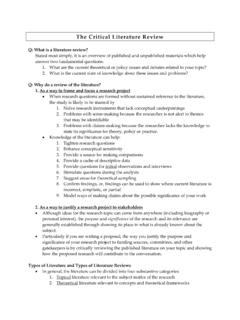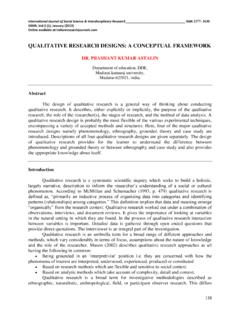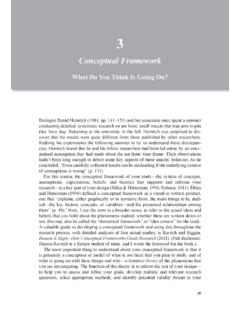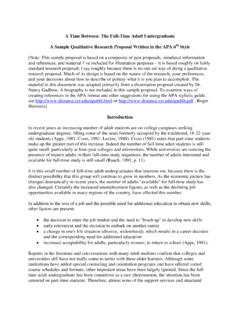Transcription of Qualitative Data Analysis - SAGE Publications Inc
1 Features of Qualitative data AnalysisQualitative data Analysis as an ArtQualitative Compared With Quantitative data AnalysisTechniques of Qualitative data AnalysisDocumentationConceptualization, Coding, and CategorizingExamining Relationships and Displaying DataAuthenticating ConclusionsReflexivityAlternatives in Qualitative data AnalysisEthnographyNetnographyEthnometho dologyConversation AnalysisNarrative AnalysisGrounded TheoryQualitative Comparative AnalysisCase-Oriented UnderstandingVisual SociologyMixed MethodsCombining Qualitative MethodsCombining Qualitative and Quantitative MethodsCase Study: Juvenile Court RecordsCase Study: Mental Health SystemCase Study.
2 Housing Loss in Group HomesComputer-Assisted Qualitative data AnalysisEthics in Qualitative data AnalysisConclusionsCHAPTER10 Qualitative data AnalysisI was at lunch standing in line and he [another male student] came up to my face and started saying stuff and then he pushed me. I said .. I m cool with you, I m your friend and then he push me again and calling me names. I told him to stop pushing me and then he push me hard and said something about my mom. And then he hit me, and I hit him back. After he fell I started kicking him. Morrill et al.
3 (2000:521)320 Chapter 10 Qualitative data Analysis321 Unfortunately, this statement was not made by a soap opera actor but by a real student writing an in-class essay about conf licts in which he had participated. But then you already knew that such conf licts are common in many high schools, so perhaps it will be reassuring to know that this statement was elicited by a team of social scientists who were studying conf licts in high schools to better understand their origins and to inform prevention first difference between Qualitative and quantitative data Analysis is that the data to be analyzed are text, rather than numbers, at least when the Analysis first begins.
4 Does it trouble you to learn that there are no variables and hypotheses in this Qualitative Analysis by Morrill et al. (2000)? This, too, is another difference between the typical Qualitative and quantitative approaches to Analysis , although there are some this chapter, I present the features that most Qualitative data analyses share, and I will illustrate these features with research on youth conf lict and on being homeless. You will quickly learn that there is no one way to analyze textual data . To quote Michael Quinn Patton (2002), Qualitative Analysis transforms data into findings.
5 No formula exists for that transformation. Guidance, yes. But no recipe. Direction can and will be offered, but the final destination remains unique for each inquirer, known only when and if arrived at (p. 432).I will discuss some of the different types of Qualitative data Analysis before focusing on computer pro-grams for Qualitative data Analysis ; you will see that these increasingly popular programs are blurring the distinctions between quantitative and Qualitative approaches to textual of Qualitative data AnalysisThe distinctive features of Qualitative data collection methods that you studied in Chapter 9 are also ref lected in the methods used to analyze those data .
6 The focus on text on Qualitative data rather than on numbers is the most important feature of Qualitative Analysis . The text that Qualitative researchers analyze is most often transcripts of interviews or notes from participant observation sessions, but text can also refer to pictures or other images that the researcher can the Qualitative data analyst learn from a text? Here Qualitative analysts may have two different goals. Some view Analysis of a text as a way to understand what participants really thought, felt, or did in some situation or at some point in time.
7 The text becomes a way to get behind the numbers that are recorded in a quantitative Analysis to see the richness of real social experience. Other Qualitative researchers have adopted a hermeneutic perspective on texts that is, a perspective that views a text as an interpretation that can never be judged true or false. The text is only one possible interpretation among many (Patton 2002:114).The meaning of a text, then, is negotiated among a community of interpreters, and to the extent that some agreement is reached about meaning at a particular time and place, that meaning can only be based on con-sensual community a hermeneutic perspective, a researcher is constructing a reality with his or her interpretations of a text provided by the subjects of research.
8 Other researchers, with different backgrounds, could come to markedly different can see in this discussion about text that Qualitative and quantitative data analyses also differ in the priority given to the prior views of the researcher and to those of the subjects of the research. Qualitative data analysts seek to describe their textual data in ways that capture the setting or people who produced this text Investigating the Social World322on their own terms rather than in terms of predefined measures and hypotheses. What this means is that Qualitative data Analysis tends to be inductive the analyst identifies important categories in the data , as well as patterns and relationships, through a process of discovery.
9 There are often no predefined measures or hypotheses. Anthropologists term this an emic focus, which means representing the setting in terms of the participants and their view-point, rather than an etic focus, in which the setting and its participants are repre-sented in terms that the researcher brings to the Qualitative data analyses also are distinguished by their focus on the inter-related aspects of the setting, group, or person under investigation the case rather than breaking the whole into separate parts. The whole is always understood to be greater than the sum of its parts, and so the social context of events, thoughts, and actions becomes essential for interpretation.
10 Within this framework, it doesn t really make sense to focus on two variables out of an interacting set of inf luences and test the relationship between just those data Analysis is an iterative and ref lexive process that begins as data are being collected rather than after data collection has ceased (Stake 1995). Next to her field notes or interview transcripts, the qualita-tive analyst jots down ideas about the meaning of the text and how it might relate to other issues. This process of reading through the data and interpreting them continues throughout the project.













